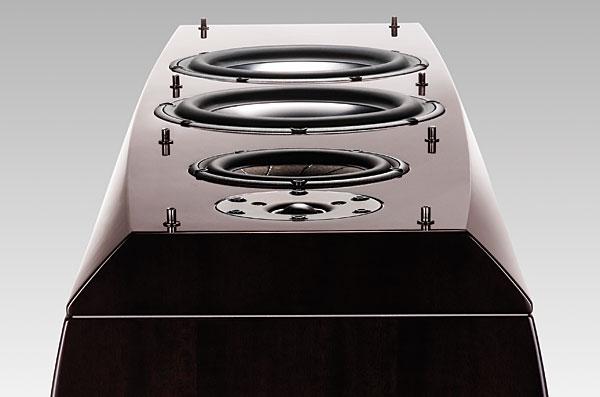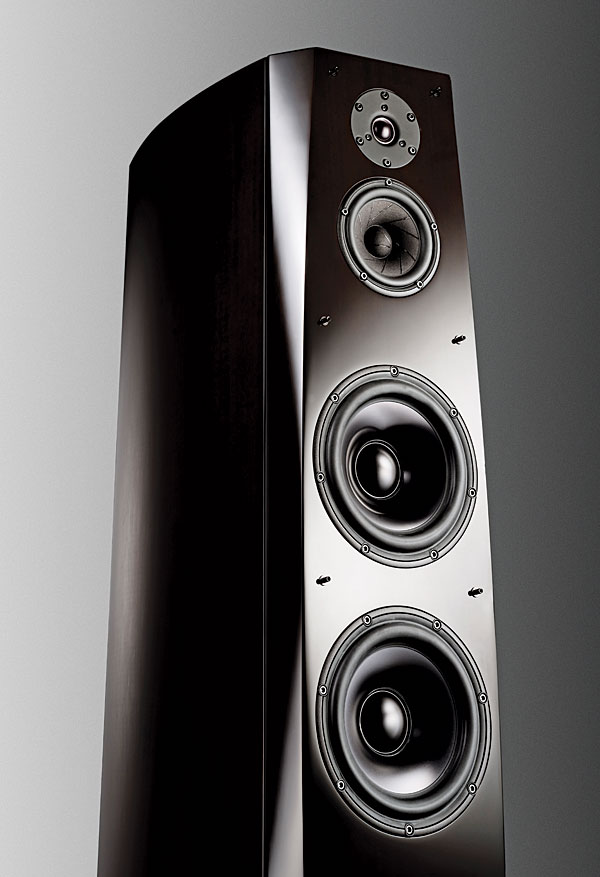| Columns Retired Columns & Blogs |
These are one of the very best sounding speakers on the market today. Breathtaking. And to top it off, they measure terrific.

The '2 The SS-AR2 looks very similar to the SS-AR1, but is 4" shorter, has twin 6.5" aluminum-cone woofers instead of the SS-AR1's 8" units, and has less extended low frequencies: a nominal cutoff of 42 rather than 28Hz. However, the SS-AR2's 1" soft-dome tweeter and the distinctive Scan-Speak 5" midrange drive-unit, with its sliced paper cone, are the same as in the more expensive speaker, as is the strategically braced cabinet construction: panels of Scandinavian birch with a 2"-thick front baffle built up of laminations of Japanese maple.
The woofers are in their own subenclosure, reflex-loaded with a gently flared port 2.5" in diameter and offset on the speaker's rear, just above the terminal panel's single pair of WBT binding posts. The midrange unit is also mounted within its own subenclosure, this loaded with a 2" port at the top of the rear panel. Tuned to a frequency below the midrange unit's passband, this port isn't used to extend the driver's lower-frequency response; instead, as in Wilson Audio designs, it allows the unit to have a greater dynamic range. The woofers and midrange have copper shorting rings on their magnet pole pieces, to reduce distortion. The tweeter's circular array of six neodymium magnets leaves the rear of its diaphragm unobstructed, and its range is claimed to extend to 60kHz. For more details, I refer you to Kal's review of the SS-AR1.
The Designer
The designer of Sony's SS-series models, Yoshiyuki Kaku, visited me last spring to set up the SS-AR2s in my listening room. After he'd pronounced himself satisfied with the review samples' sound, I asked him about loudspeakers in general and the SS-AR2 in particular. (My thanks to Sony's Motoyuki "Yuki" Sugiura for serving as interpreter.)
Kaku-san had originally been assigned to Sony's semiconductor division, but crossed over to the audio division more than 20 years ago. He explained that concertgoing was an important part of his life, and that his goal for the loudspeakers he designs differs somewhat from the standard "high-fidelity" approach. Even before musicians begin a performance, he told me, there is a special atmosphere in the hall as they take the stage—something that makes you excited. He looked at what is required to reproduce that atmosphere through loudspeakers, and found that it was a combination of dynamic-range capability and power linearity, so that the speaker doesn't add noise, coloration, or distortion while sounding the same at both low and high levels.

He also wanted to avoid any character imparted to the sound by the radiation from the speaker cabinet. About 15 years ago, Kaku took a bookshelf speaker with a 5" woofer and a rigid cabinet with walls 32mm thick, and isolated that cabinet by enclosing all surfaces of the speaker, other than the baffle, in a second cabinet. The resonant contributions of the original cabinet thus nullified, the result sounded completely different.
He experimented with many different enclosure materials, including aluminum, but no matter how stable and solid he made a loudspeaker's cabinet, it still produced sound, ie, distortion. The important thing, therefore, would be to control that cabinet-produced sound: If the wood is going to vibrate anyway, choose a wood whose vibrations can be controlled, and are consonant with the music, not dissonant to it. "The sound coming from the cabinet should be as beautiful as possible," he told me.
For the first third of the development period for the SS-AR1 and '2 , Kaku depended entirely on anechoic measurements, first getting the response flat, then selecting the drive-units so that the speaker's behavior remained linear as the sound-pressure level increased—only then could the actual design work begin. After many hours of listening, the choice was made to use Scandinavian birch for the close-tolerance enclosure, and 2"-thick laminated maple for the baffle. The speaker was already a "high fidelity" design before these listening sessions, but this fine tuning was the most important part of the process, "even if it doesn't appear in the measurements."
Maple is a hardwood that has been used for hundreds of years for the bodies of musical instruments, such as the violin. There are many different kinds of maple; the SS-AR speakers are made of Hokkaido maple from Japan's northernmost major island; the wood is harvested in November, when growth is slow and the grain is tight. The result is a wood that is stiff but internally damped—compared, for example, with aluminum, which is stiff but not lossy.
I asked Kaku-san why, if Sony is fully capable of developing its own high-tech drivers—remember their flat APM units from a quarter-century ago—he chose ones made by an outside vendor. He replied that the drive-units custom-made by Scan-Speak for Sony gave him what he wanted in terms of power linearity and ultimate sound quality, and it is the latter that most matters to the customer.
At the end, I asked Yoshiyuki Kaku which sound was most important to him. His answer: "the human voice."
The Sonics
At the spring 2012 shows where I first heard the SS-AR2, I'd been struck by its mellow balance. I had put this down to the large rooms in which it was being demmed—assuming that a loudspeaker with a 1" dome tweeter is to be used in a room of average size, its designer will optimize the top-octave response by balancing the on-axis energy against the restricted dispersion in the same region. In a room much larger than average, the lack of energy in the reverberant field will result in too mellow a balance. But in my own room, which is approximately 26' by 16' by 8', the SS-AR2's balance still sounded sweet, if not actually mellow.
Admittedly, the last two speakers to have resided in my room—the Lansche 5.1, reviewed in July, and the PSB Imagine Mini, reviewed in August—were far from reticent in the top octaves, and this might have affected my expectations. The Sony SS-AR2 is not a speaker for audiophiles who value sizzle for its own sake, but this is not to suggest that it obscured treble detail. The filigree details in Burt Bacharach's sparse arrangement for Dionne Warwick's recording of his "Walk On By," from The Burt Bacharach Collection (Apple Lossless file ripped from CD, Rhino R2 75339), such as the low-level vibes in the verses, were laid out clearly without being spotlit in any way.
And while the Sony's balance was kind to bright recordings—I've been listening a lot recently to 1970s Little Feat bootlegs, which share, along with Lowell George's genius, an overcooked treble—cymbals still sounded like clearly differentiated instruments made of bronze rather than anonymous sources of white noise. The Sony may sound a bit mellow, but it still readily distinguished between the different high-pitched percussion instruments in George Benson's "This Masquerade," which underpin the difference in feel between Benson's funky version on his Breezin' (Apple Lossless file ripped from CD, Warner Bros.) and the Carpenters' white-bread, all-white-notes arrangement on their Now and Then (Apple Lossless file ripped from CD, A&M). Don't get me wrong—I have a huge respect for the Carpenters. Who can hear Karen effortlessly projecting the vocal line of "Goodbye to Love," imperceptibly grabbing breath without disturbing the long, meandering melody, without tearing up? But "This Masquerade" was their nadir.
I don't think I've heard more natural reproduction of female voices in my listening room. The images of Dionne Warwick and Karen Carpenter were palpable. Using Ayre Acoustics' new QA-9 USB A/D converter, I recently ripped, to a 24-bit/192kHz AIFF file, the late Radka Toneef's reading of Jimmy Webb's "The Moon Is a Harsh Mistress," from her Fairytales (LP, Odin LP03)—an audiophile favorite of the 1980s. Unlike the PSB Minis, the Sonys didn't emphasize the inevitable clicks and ticks on my much-played copy. Toneef's voice is a reedy, slender thing—she almost whispers the opening line, "See her, how she flies"—but the way she uses grace notes, and points the ends of phrases with vibrato, are masterful. Along with the mono reverb behind the image of her voice, the SS-AR2s laid all of this bare without making the voice sound too slender, too clear. And at the key change after Steve Dobrogosz's piano solo, as Toneef sings "I fell out of his eyes, I fell out of his heart," the way her voice almost breaks with emotion, was superbly uncovered by the Sonys.

These are one of the very best sounding speakers on the market today. Breathtaking. And to top it off, they measure terrific.